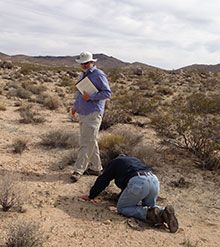In the debate that’s raging among the world’s conservationists about which plant and animal species endangered by climate change should be rescued and which are expendable, given limited resources for coping with this crisis, a small band of UCLA botanists is fervently championing a desert plant that most of us have never seen or heard of.

Blooms of the finicky Lane Mountain milkvetch. Photos courtesy of the Department of Ecology and Evolutionary Biology.

If the last remaining Lane Mountain milkvetch dies in a long-term drought, few would mourn its passing more than these dedicated scientists who have been tracking its viability for 13 long years.
Part of the Department of Ecology and Evolutionary Biology in the UCLA College of Letters and Science, they have experimented with soils, water and other conditions to increase its chances of survival. Over the last three years, they have painstakingly grown milkvetch from tiny seeds and replanted them in harsh, rocky desert terrain with high hopes that they’ll take.
The Lane Mountain milkvetch may be the Mojave Desert’s most endangered plant, according to botanist Tom Huggins. Since scientists started counting milkvetch in 1999, the population has been steadily declining despite a few years of uptick, said Rasoul Sharifi, a UCLA associate research ecologist engaged in the struggle to save the plant. The scientists fear that, with successive years of drought, they are losing the battle, although that’s difficult to predict. The plant, a perennial that can live 20 to 25 years, dies back each summer and can re-sprout or go dormant for two years or longer.

A sign warns of the presence of the endangered plant.
Worse still, milkvetch is extremely finicky about its neighbors. “The milkvetch is a very strange thing,” said Huggins. “It’s a species that’s ecologically very rare. And so we give value to things that are rare. But it’s not just that it’s rare. It’s ecologically unique in that it requires a host shrub to survive.”
For unknown reasons, it seeks the protective embrace of a small number of other desert shrubs. In fact, milkvetch is nearly invisible as it grows hidden inside the dense tangle of stems and leaves of its chosen host.
“You can’t see them,” said Huggins. “You see them only when they are mature enough to pop out of the host shrub and flower,” a process that takes at least two years from the time they start to sprout in their hidden lair.
The UCLA botanists have discovered yet another obstacle to its survival. “It has picked as an adversary,” said Huggins, “the most common and competitive plant in the North American desert” — Larrea tridentata or the creosote bush, a prolific shrub that so dominates the desert landscape that it has probably been seen by everyone who has ever crossed the Mojave traveling from L.A. to Las Vegas. Milkvetch refuses to grow in the same soil as this plant “king” of the desert.
“That’s why we think the milkvetch is so endangered,” Huggins said. “It’s restricted to an area where the number of creosote bush is very low.”
With grant money from the Army and the Bureau of Land Management, Huggins and colleagues Sharifi, Barry Prigge and Philip Rundel collected the plant’s tiny seeds that measure just a little larger than tiny sesame seeds. Using sandpaper and good eyesight, students “scarified” them, rubbing off a bit of the seed coat to encourage germination. The seeds that sprouted were then repotted and finally replanted in the desert where they were grown under various conditions and in different soils.

Botanist Tom Huggins siphons water onto a milkvetch seedling hiding in a host shrub. The UCLA scientists haul water to any surviving milkvetch they find.
“These things are very particular. So it’s a laborious process to get them to take,” Huggins said. They need special soil, they need to be planted directly under their host shrubs, and those shrubs need to be protected from herbivores like insects, lizards and birds, he said. Above all, they need extra water.
“If we don’t get at least 4 inches of rain, we really can’t say how many are alive, dead or dormant. And we’re the only university botanists on the scene,” said Huggins, who now has 13 years’ worth of data to work with, making the milkvetch a model plant for researchers to see how these special plants are adapting to climate change.
Is it worth all that effort? Huggins and Sharifi don’t hesitate to argue that it is.
“Climate change will kill off the wimps, like the milkvetch, leaving us with just boring plants,” Huggins said. “When we think about what should be saved, people should understand it’s these ecologically unique species that contribute to ecosystem diversity.”




